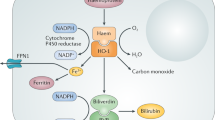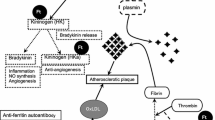Abstract
Chronically inflamed tissues contain significant concentrations of oxygen radicals, possibly generated by transition metal species such as Fe(II) and Cu(I). In addition, the pH of such tissues may well be lower than that of normal counterpart tissues. In this communication, the effect of variation of pH on the antioxidant activity of caeruloplasmin (a copper-containing acute-phase protein possessing important ferroxidase and other antioxidant activities) and of heparin are reported. Heparin, unlike caeruloplasmin, retains antioxidant activity at low pH. Heparins possess a variety of metal cation-binding chemical groups allowing them to bind damaging Cu(I) and Fe(II) ions and consequently prevent their redox involvement in oxygen radical-generating Fenton reactions. In conclusion, heparins may function as endogenous antioxidants and sequestration and/or oxidation by them, of ions such as Fe(II), may contribute to their effectiveness.
Similar content being viewed by others
References
D. Grant, W. F. Long and F. B. Williamson,Pericellular heparans may contribute to the protection of cells from free radicals. Medical Hypotheses23, 67–72 (1987).
D. Grant, W. F. Long and F. B. Williamson,Effect of heparin on dismutation of superoxide anion. Biochem. Soc. Trans.16, 1030–1031 (1988).
L. M. Hiebert and J. Liu,Heparin protects cultured endothelial cells from damage by toxic oxygen metabolites. Atherosclerosis83, 47–51 (1990).
D. Grant, W. F. Long, M. A. Ross and F. B. Williamson,Structural features of glycosaminoglycans and proteins relevant to free radical biochemistry. Proc. Harden Conf. Biochem. Soc. 34th, 52 (1990).
J. M. C. Gutteridge,Bleomycin-detectable iron in knee-joint synovial fluid from arthritic patients and its relationship to the extracellular antioxidant activities of caeruloplasmin, transferrin and lactoferrin. Biochem. J.245, 415–421 (1987).
D. Grant, W. F. Long and F. B. Williamson,A study of Ca 2+-heparin complex-formation by polarimetry. Biochem. J.282, 601–604 (1992).
J. A. Knight and R. P. Voorhees,Peroxidation of linolenic acid — catalysis by transition metal ions. Ann. Clin. Lab. Sci.20, 347–352 (1990).
M. A. Ross, W. F. Long and F. B. Williamson,Inhibition by heparin of Fe(II)-catalysed free radical peroxidation of linolenic acid. Biochem. J.286, 717–720 (1992).
D. Grant, W. F. Long and F. B. Williamson,Inhibition by glycosaminoglycans of CaCO 3 (calcite) crystallisation. Biochem. J.259, 41–45 (1989).
D. Grant, W. F. Long and F. B. Williamson,Complexation of Fe 2+ ions by heparin. Biochem. Soc. Trans.20, 361S (1992).
Author information
Authors and Affiliations
Rights and permissions
About this article
Cite this article
Grant, D., Long, W.F., Mackintosh, G. et al. Heparins as essential antioxidants. Agents and Actions 41 (Suppl 2), C214–C215 (1994). https://doi.org/10.1007/BF01987642
Issue Date:
DOI: https://doi.org/10.1007/BF01987642




